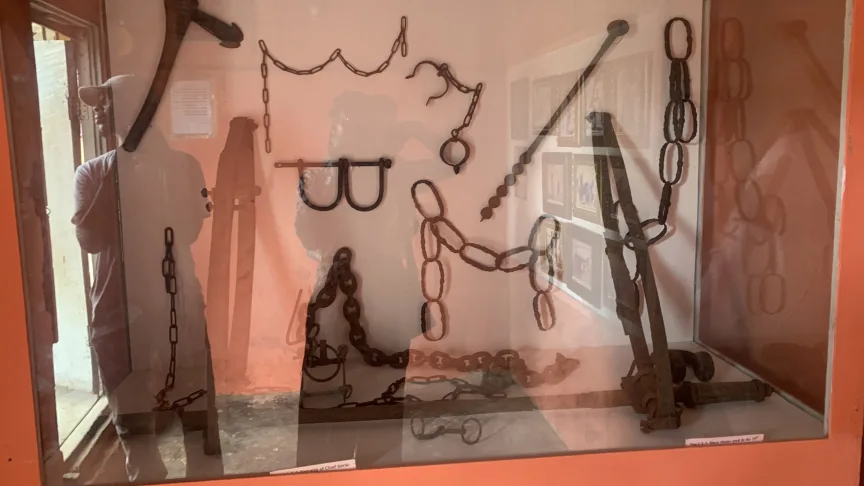I spent a weekend in Badagry, just a few hours from the busy city of Lagos, and it turned out to be more than a getaway — it was a journey through time, memory, and connection.
Badagry is one of those places that leaves a mark on you long after you leave. The moment you arrive, the air feels different. Badagry is quiet but powerful. It carries history in its soul.
Badagry town was founded around the 1720s and became one of the major slave ports in West Africa. It was from here that thousands of Africans were taken across the Atlantic, never to return. For Africans in diaspora, this town is not just a tourist spot, it is a bridge to their ancestors.
 Walking through Badagry feels like standing at the doorway of history.
Walking through Badagry feels like standing at the doorway of history.
You sense pain, pride, and resilience all at once.
My first stop was at the Mobee Slave Relics Museum. This place has original relics, iron chains, handcuffs, and trade items used by Europeans in exchange for people. It was emotional listening to the guide explain how families were separated and how some were never seen again. But it was also a place of strength.
 The Mobee family turned their painful history into a place of learning, so visitors can see and never forget.
The Mobee family turned their painful history into a place of learning, so visitors can see and never forget.
Not far from the Mobee Museum stands one of the most haunting sites in Badagry, the Serriki Wiliams Abass Slave Barracoon. It is a small dark room where dozens of men, women, and children were once kept before being taken to the ships. The air inside is heavy, and the walls seem to hold silent cries. It is hard to stand there without feeling emotional. The guide explained that people were kept there for days, sometimes weeks, waiting for ships to arrive.
 A painful place, but an important reminder of how strong the human spirit can be.
A painful place, but an important reminder of how strong the human spirit can be.
My next stop was at the First Storey Building in Nigeria, built by Christian missionaries around 1845. It’s a small white structure, but standing in front of it feels special. It represents the beginning of Western education and religion in Nigeria. I climbed up the narrow stairs and looked out through the window, thinking about how much memories this building holds, the early missionaries, the locals who learned to read here, and the changes that came after.

Then it was time to get to the “Point of No Return”. This path starts from the the lagoon, and ends on a narrow road that meets the Atlantic Ocean. It’s about a 2.5-kilometer walk, but every step feels heavy. The name “Point of No Return” wasn’t just symbolic, it was the literal last land enslaved Africans touched before being shipped away. The silence there is deep. You can hear the sea, the wind, and your own thoughts. Some visitors pour water or sand into bottles as a way to carry a piece of memory back with them. I stood there for a while, looking out at the endless water, and felt both sadness and gratitude. Sadness for what happened, and gratitude for being able to stand there freely.
Badagry is not only about history, it is also about community and resilience. The people are warm and proud of their heritage. Talking to the locals, you can tell they are working hard to preserve their town’s history while also building a better future through tourism.
For Africans in the diaspora, visiting Badagry can be a deeply emotional experience. It’s not just about sightseeing, it’s about reconnecting with identity. Many who come here say it feels like coming home, even if they’ve never been to Nigeria before. Walking that same route their ancestors once took, standing where history changed forever, brings a sense of closure and healing. Badagry offers that, a space for reflection, education, and spiritual connection.
If you ever plan to visit, take your time. Go with an open heart. Spend at least a weekend so you can explore slowly and take everything in. Badagry gives you a chance to understand history from where it happened and to feel connected to something bigger than yourself. For me, this weekend wasn’t just about travel, it was about remembrance, reflection, and rediscovery.
Every African, especially those in the diaspora, should visit Badagry at least once. Let the journey remind you of strength, survival, and the beauty that still rises from pain. Travel, after all, isn’t only about where we go, it is about finding pieces of ourselves along the way.
About the author — Esther Chinaza is a traveler and tour guide based in Nigeria. Connect with Esther on Travel Massive, Instagram, and her travel blog Explore With Eva.

Comments
Definitely visiting Badagry for weekend getaway
You really should!
It’s such a powerful experience.
Thanks for sharing your experience
Thank you!
Thank you Esther for sharing your experience with us .
Thank you!